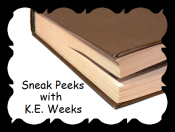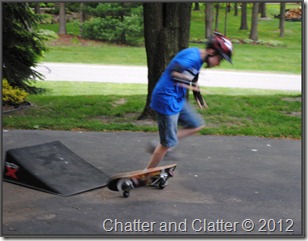 |
| This feature is presented by guest blogger, K.E.Weeks. |

The novel is well-written and exceptionally well-plotted. The book has several big twists and reveals, which I am loathe to give away here. The characters are realistic and lively, and the description is detailed and interesting. For example,
You’d have thought I’d be used to this by now. Being the new kid and all. I’d been through this umpteen times before but it never gets any easier. Still, there’s certain things every school’s got, same as any other. Universals, I call them....My one consolation was that I knew these kids. Even if they didn’t know me. Kids are universals too, in a way. Every school has the ones who think they’re a little better than everybody else and the ones who are a little poorer than everybody else. And somewhere in the mix there’s usually ones who are pretty decent. Those were the ones who made it hard to leave when the time came. And sooner or later, it always came (Vanderpool 26).As the book progresses, Abilene learns more about her father and his past in this town, as well as all of the secrets lurking in a small town. There is no romance and very little violence with the exception of some fistfighting, a Klan cross burning, and a murder which is entirely “off stage” and not actually seen. There is some bootlegging during Prohibition and discussion of strong drink, but only one character is ever “seen” drunk and the irony is that she does not realize she has been drinking alcohol until it is too late. A small scene in the beginning has a fortune telling. Overall, though, there is little here that most parents would find offensive.
I have only two minor criticisms of the book: the pace and the complexity. First, the pace is a bit slow in the beginning. The latter half of the book is exciting and page-turning, but the first half meanders for a long time, setting the stage. I maintained interest, but a young reader might become bored before reaching the thrilling parts.
Second, the complexity might confuse young readers. Overall, I am pleased to see a young adult novel with substance. Too often books for the YA audience are shallow, and Moon over Manifest is definitely not that. Still, the bouncing between two time periods can create confusion and the vast number of characters to keep straight—with names like Callisto Matenopoulos and Nikolai Yezierska!— might overwhelm even strong readers. The author includes a list of characters at the beginning of the book, which helps considerably, but it is still difficult to keep everyone straight. Moreover, without some historical background (such as a cursory understanding of WWI and the Spanish Influenza epidemic of 1918), the book would lose some depth. I would not recommend this book for a reluctant or struggling reader for the reasons mentioned and because it changes font in each chapter, although he or she may enjoy it on CD.
If you have a strong reader who is ready for substantial plots and complicated characters or if you are studying Prohibition, the Great Depression, or WWI, this is an excellent book which both boys and girls in 5th – 9th grade will like. I can see why it won the Newberry Medal. I give Moon over Manifest five (out of five) stars.
Disclaimer: The purpose of this review is to guide parents into selecting appropriate, significant, high-quality literature for their teens and tweens. I have no connection with the author or publisher of this book. I am a home educator of two children, 12 and 15, with a Master of Art degree in American Literature and a keen interest in young adult fiction and nonfiction.
*Contains affiliate links




